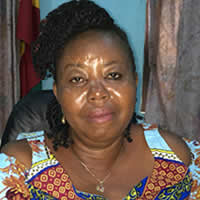

Education is seen as a lifelong process, which empowers individuals and communities to develop awareness of themselves and take an intelligent and sympathetic interest in their environment. This section looks at the literacy level, educational level, and number of schools, enrollment trends, teacher pupil ratio, and school participation rate among others of the District
That there are more boys attending school than girls and the numbers of people who drop out from attending the junior secondary school are more pronounced with girls
than boys.
School Drop Out Rate
The drop out rate for females is higher than that of females at all levels of education. Females will be marginalized in decision making in the district and also their contributions to productivity will be low as compared to the males.The above table clearly spells out the number and type of teachers at all levels of schools in the district. It could be ascertained that the number of untrained teachers in the pre schools outnumbers the number of trained teachers.
This affects the performance of pupils especially at the primary level since the foundation of the basic level is weak. Most of the people therefore cannot continue their education, especially the girls at the second cycle institutions because their grades cannot compete with those in other schools. This has contributed to the many unemployed youth in the district. The number of students who qualify for secondary school increases over the years. The number of males who qualifies for secondary school outnumbers that of female. More resources and incentives needs to be put in place to help improve the current performance of the schools in the district.
Participation rate in the district increases at all levels of institution. The school participation rate in the district is estimated to be 87.1%, which compares favorable with the national situation of 80%. The perpetuation of this trend will increase the literacy rate.
The inactive group (6-14 and 65 and above) of the population are illiterate, whiles in the active age group the literates dominate. This implies that the inactive age group can be well catered for. Collection and dissemination of development will be easy.
Most of the people (46.5%) who are employed have never attained education. In addition, majority (78.1%) of the unemployed people have not had any form of education. Again, majority (41.7%) of the people who have attained education ended at the J.S.S/ middle school level. This implies that there is going to be low level of productivity since rudimentary methods of production are likely to be used because the people employed are illiterates.
Educational Level and Type of Occupation
In the District, most (49.3%) of the people who have never attained education or have extremely low level of education (nursery) are found in the agric sector (farmers). Majority of those who have attained higher levels of education are found in the service sector. A positive correlation coefficient of 0.68 exists between the educational level of the people and their occupational type. This implies that productivity in the agricultural sector will be low, post harvest loses, and rudimentary methods of production will prevail in the district.
The number of females (45.9%) that has never attain education outnumber the males (32.6%). Also the number of males (12.9% and 5.0%) that attains SSS and tertiary school respectively out number the females (4.1% and 1.3%). This implies that the relevance of the girl child education is still not understood in the district. In addition, productivity level is going to be low, as most females do not attain higher level of education.
Skills and Entrepreneurial Development
This sub-sector looks at the avenues available for the development of employable skills in the district. The unavailability of data limited the studies only to the Business Advisory Centre (BAC)
The Business Advisory Centre in the District
The district has a business advisory centre which assists in training mostly the youth in employable skills. The centre has instituted a number of programmes like technical training in vocational activities management seminars and many more. These programmes are targeted at the unemployed youth, peasant farmers among others. Some of the beneficiary communities of these programmes are at Ejura, Samari Nkwanta and Sekyeredumasi.
The roles of the department include among other things; providing business counseling and extension services, organizing management and technical training and facilitating clients’ access to financial service. In order to achieve the department targets and goals many programmes has been undertaking in the district. These include; technical training in soap making. at Ejura, training in Grass cutter rearing at Samari Nkwanta, training in mushroom farming at (Sekyeredumase), management seminars at Ejura and many more.
The targeted groups of this department include unemployed youth, peasant farmers, hairdresser/dressmakers, flour users, apprentices and many more. In undertaking the programmes, the department is get funds and support from National Board for small-scale industries (NBSSI), World Vision and MOFA. Some of the achievements of the department include; establishment of the graduate apprentices support fund and giving refresher courses to small and medium scale enterprises (SME).
Date Created : 11/18/2017 6:41:22 AM











 facebook
facebook
 twitter
twitter
 Youtube
Youtube
 +233 593 831 280
+233 593 831 280 0800 430 430
0800 430 430 GPS: GE-231-4383
GPS: GE-231-4383 info@ghanadistricts.com
info@ghanadistricts.com Box GP1044, Accra, Ghana
Box GP1044, Accra, Ghana